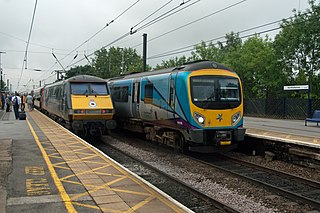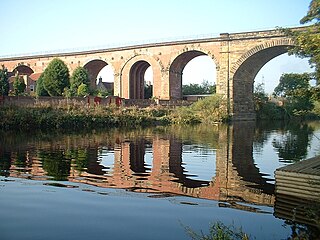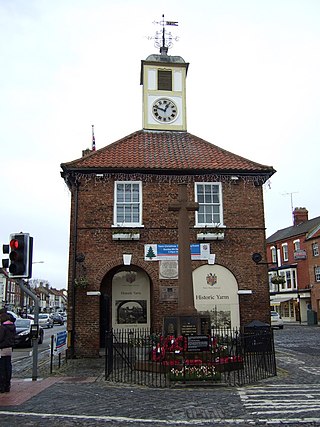
North Yorkshire is a ceremonial county in the Yorkshire and the Humber and North East regions of England. It borders County Durham to the north, the North Sea to the east, the East Riding of Yorkshire to the south-east, South Yorkshire to the south, West Yorkshire to the south-west, and Cumbria and Lancashire to the west. Northallerton is the county town.

Ripon is a cathedral city and civil parish in North Yorkshire, England. The city is located at the confluence of two tributaries of the River Ure, the Laver and Skell. Within the boundaries of the historic West Riding of Yorkshire, the city is noted for its main feature, Ripon Cathedral, which is architecturally significant, as well as the Ripon Racecourse and other features such as its market.

The North Riding of Yorkshire was a subdivision of Yorkshire, England, alongside York, the East Riding and West Riding. The riding's highest point was at Mickle Fell at 2,585 ft (788 m).

Northallerton is a market town and civil parish in North Yorkshire, England. The town is located near the River Wiske in the Vale of Mowbray. It had a population of 16,832 in the 2011 census, an increase from 15,741 in 2001. Northallerton is the county town of North Yorkshire and the administrative centre of North Yorkshire Council; until 1974 it was part of the North Riding of Yorkshire, of which it was also the county town.

Leyburn is a market town and civil parish in North Yorkshire, England, sitting above the northern bank of the River Ure in Wensleydale. Historically in the North Riding of Yorkshire, the name was derived from 'Ley' or 'Le' (clearing), and 'burn' (stream), meaning clearing by the stream. Leyburn had a population of 1,844 at the 2001 census increasing to 2,183 at the 2011 Census. The estimated population in 2015 was 2,190.

North Yorkshire Police is the territorial police force covering the unitary authorities of North Yorkshire and the City of York in northern England. As of September 2018 the force had a strength of 1,357 police officers, 127 special constables, 192 PCSOs and 1,072 police staff. Of the 43 territorial police forces in England and Wales, the force has the 3rd largest geographic area of responsibility whilst being the 15th smallest force in terms of police officer numbers.

Stokesley is a market town and civil parish in North Yorkshire, England. It lies within the historic county boundaries of the North Riding of Yorkshire, on the River Leven. An electoral ward of the same name stretches north to Newby and had a population at the 2011 Census of 5,537.

Romanby is a village and civil parish in the Hambleton District of North Yorkshire, England. Romanby is situated just south-west of Northallerton, and at the 2001 UK census had a population of 6,051, increasing to 6,177 at the 2011 Census.

Northallerton School is a coeducational secondary school and sixth form located in Northallerton, North Yorkshire, England. The school is located over two sites on Brompton Road and Grammar School Lane.

Leeming Bar is a village in the civil parish of Aiskew and Leeming Bar, in North Yorkshire, England. The village lay on the original Great North Road before being bypassed. It is now home to a large industrial estate and the main operating site of the Wensleydale Railway. It is in the historic North Riding of Yorkshire.

Kirby Sigston is a village and civil parish in the Hambleton district of North Yorkshire, England, approximately 4 miles (6.4 km) east of Northallerton. The village is situated on the Cod Beck river, and the wider parish contains the hamlet of Jeater Houses due east of the village on the trunk A19 road.

HM Prison Northallerton was a prison in Northallerton, North Yorkshire, England. It operated from 1788 until December 2013. During that time, it variously housed male and female adult prisoners, women with children, youth offenders, and military prisoners. Latterly Her Majesty's Prison Service struggled to keep the old prison operating to modern standards, and citing the costs of doing so and the relatively small size of the institution, it closed the prison in 2014. The prison was bought by Hambleton District Council, which is currently redeveloping the site.

North Yorkshire Fire & Rescue Service is the statutory fire and rescue service covering the area of the unitary authorities of North Yorkshire and the City of York. The service covers an area of 3,209 square miles (8,310 km2) and serves a population of 830,000. It is divided into eight groups related to the above districts.

North Yorkshire Council is the unitary authority which governs the non-metropolitan county of North Yorkshire, within the larger ceremonial county of North Yorkshire, in England. North Yorkshire was a two-tier non-metropolitan county from 1974 to 2023, when North Yorkshire Council was a county council called North Yorkshire County Council. On 1 April 2023 the seven lower-tier districts of the county were abolished and their functions taken over by the new unitary authority.

Brompton railway station was a railway station that served the community of Brompton, 1 mile (1.6 km) north east of Northallerton in North Yorkshire, England. It was opened in 1854 and closed in 1965. The line it was on is still open and carries passenger traffic to and from Sunderland and Middlesbrough to Manchester Airport and London King's Cross.

The network of railways in Northallerton, North Yorkshire, England, was constructed by three companies whose lines through the town were built between 1841 and 1852. They were all amalgamated into the North Eastern Railway (NER) which in turn was subsumed into the London and North Eastern Railway in 1923 and British Rail in 1948. British Rail closed two lines, the Wensleydale line in 1954 and a section of the Leeds Northern Railway to Harrogate in 1969. The Wensleydale line was retained as a freight branch and resurrected as a heritage railway in 2003 but the line to Harrogate closed completely. Despite closures and rationalisation, the station still is at a major junction on the East Coast Main Line.

Yarm Viaduct is a railway viaduct carrying the railways above the town of Yarm in North Yorkshire, England. It crosses the River Tees which forms the boundary between North Yorkshire and County Durham. The railway runs between Northallerton and Eaglescliffe, and was opened in 1852 as part of the extension of the Leeds Northern Railway to Stockton-on-Tees. The line and viaduct are currently owned and maintained by Network Rail and carries passenger traffic for TransPennine Express and Grand Central train operating companies. It also sees a variety of freight traffic.

Yarm Town Hall is a municipal building in the High Street in Yarm, North Yorkshire, England. The structure, which is the meeting place of Yarm Town Council, is a Grade II listed building.

Northallerton Town Hall is a municipal building in the High Street, Northallerton, North Yorkshire, England. The structure, which is the meeting place of Northallerton Town Council, is a grade II listed building.

Stokesley Town Hall is a municipal building in the Market Place in Stokesley, North Yorkshire, England. The structure, which accommodates the offices and meeting place of Stokesley Town Council, is a grade II listed building.





















